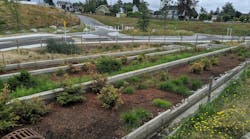Charles River Running Dry
Water levels in the Charles River have reached their loweset point in 16 years. Conservationalists are concerned about increased pollution levels and damage to fish and wildlife from development in Boston's western suburbs and a recent dry spell.
A state water-level-monitoring station in Dover, Mass., measured a flow rate of 7.7 cu ft per second; the Dover gauge, although seasonal and weather conditions cause flow rates to vary widely, has registered a reading so low only a dozen times in the 71 years the river's flow rates have been monitored and recorded, said Nigel Pickering of the Charles River Watershed Association.
"At first we thought it was just a normal dry period, but this is something different," he said. "Some stretches of the river are pretty close to dry right now."
In response to the low water levels and the threat they pose to river wildlife, the association issued an e-mail encouraging water quality monitoring volunteers to help document the situation. Volunteers like Terry Stone of Newton were asked to replace their buckets and sample jars with digital cameras so as to help identify particularly troublesome stretches of river.
"They were looking for people to take pictures of some of the features of the river that aren't normally above water," said Stone, a lawyer and fisherman whose house sits about 300 ft from the river in Newtonville. "It was very low. If you looked at Cheesecake Brooke [a tributary of the Charles that runs through Newtonville], it looked like Cheesecake Beach.
Less water, said watershed association project manager Anna Eleria, means higher pollutant concentrations in the river and therefore, in fish, which are in turn eaten by birds, turtles and other wildlife. Low flows also make it difficult for many fish populations to migrate to the ocean. Eleria added that the timing of this situation is especially bad considering her group and the U.S. Fish and Wildlife Service are in the second year of a American shad fry restoration project in the Charles. "It's something we're pretty concerned about," she said of the program.
Even fish which prefer relatively static water, for instance largemouth bass, sunfish and American eels, are feeling the stress of the low-water conditions, Eleria said. The low water levels, too, magnify the negative effect of recent algae blooms in the river, triggering a wild pendulum effect on wildlife oxygen and carbon dioxide levels, she added.
Development and population booms in suburbs including Milford, Dover, Medway and Lincoln have decreased groundwater levels that would otherwise make up part of the river flows during periods of no or little rain. Construction, too, increases the amount of rainwater diverted into storm drains, where it bypasses natural groundwater and river systems.
Pickering said that state and federal officials, along with the association, are working to promote stricter water-use regulations and storm water management plans to prevent extreme low water levels in the Charles. "We would like everyone to share the pain," Pickering said. "Both the fish and the people."
Source: The Boston Globe

